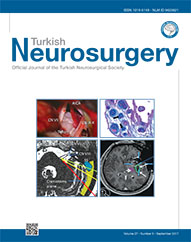2São Francisco Hospital School, Department of Neurosurgery, Bragança Paulista ? SP, Brazil
3São Francisco University, School of Medicine, Bragança Paulista ? SP, Brazil DOI : 10.5137/1019-5149.JTN.17412-16.2 AIM: To evaluate the follow-up results of patients who underwent surgical treatment for distal anterior cerebral artery (pericallosal artery) aneurysms and compare our results with the literature.
MATERIAL and METHODS: Nineteen patients were operated between 2000 and 2013 with preoperative angiography and computed tomography (CT) studies. Fisher"s classification and World Federation of Neurosurgical Societies (WFNS) subarachnoid hemorrhage (SAH) scale were used to classify the CT findings of the patients. In addition to the clinical and radiological analyses, bibliographical review in indexed databases was also performed.
RESULTS: The female/male ratio was 4:1 and the average age was 34 years. The right side was affected in 53% of cases and 42% of the aneurysm was ruptured. Distribution of the ruptured aneurysms based on Fisher"s classification was as follows: Fisher IV in 25% of the cases, Fisher III in 37.5%, Fisher II in 12.5%, and Fisher I in 25% of the cases. The ruptured aneurysms were Grade I in 50% of cases, Grade III in 12.5%, and Grade IV in 37.5% of the cases according to the WFNS grading scale. The average size of the aneurysms was 3.5 mm, and ranged from 3 to 8 mm. One was fusiform and the others were saccular type of aneurysms. The aneurysm was located in fronto-polar artery in 53% of the cases, while in the callosomarginal artery in 47% of the cases. Multiple aneurysms were detected in 6 patients. There was no mortality due to surgery.
CONCLUSION: Pericallosal artery aneurysms should have a better prognosis than the aneurysms located in the other parts of the circle of Willis. Complications are related to the patients" age. If possible, these aneurysms should always be clipped due to potential risk of bleeding and difficulty of embolization.
Keywords : Aneurysm, Subarachnoid hemorrhage, Pericallosal artery




